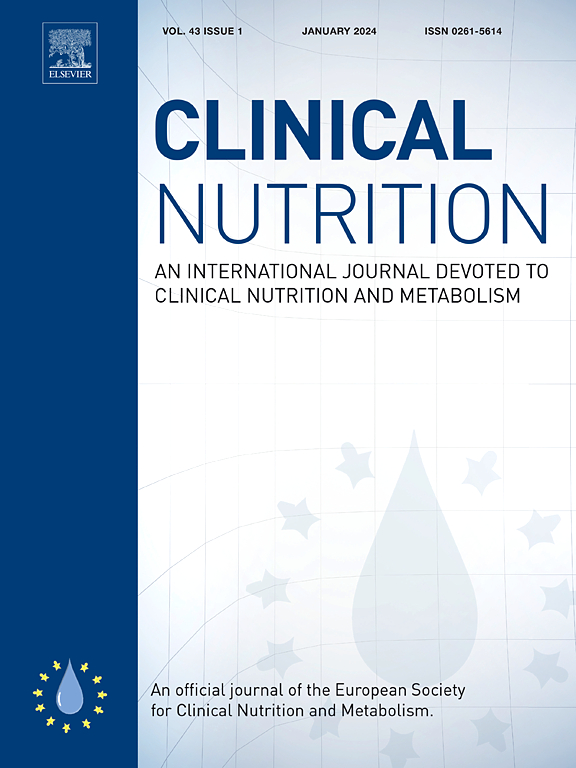Low plasma pancreatic lipase as a novel predictor of nutritional target achievement and response to nutritional interventions in malnourished inpatients: Secondary analysis of a randomized clinical trial
IF 6.6
2区 医学
Q1 NUTRITION & DIETETICS
引用次数: 0
Abstract
Background & aims
Pancreatic lipase plays an essential role in digesting dietary fats in the intestine, facilitating nutrient absorption. Plasma lipase serves as a surrogate for pancreatic exocrine function, which decreases with age and potentially leads to inadequate nutrient digestion and gastrointestinal symptoms. We investigated clinical implications of plasma lipase among medical inpatients at nutritional risk.
Methods
This secondary analysis investigated admission plasma lipase concentrations among patients at risk for malnutrition regarding clinical outcomes and treatment response in patients included in the Effect of Early Nutritional Support on Frailty Outcomes, and Recovery of Malnourished Medical Inpatients Trial (EFFORT), a randomized controlled trial comparing individualized nutritional support to usual care.
Results
Of 810 patients with available admission plasma lipase concentrations, 158 (19.5 %) had concentrations below the reference range. Patients with low concentrations had a 1.6-fold higher risk of not reaching energy or protein targets during hospitalization (adjusted odds ratio 1.62 [95 % confidence interval 1.07 to 2.45], p = 0.022 and 1.61 [95 % confidence interval 1.07 to 2.44], p = 0.023, respectively). They also tended to have a more pronounced benefit from nutritional interventions in terms of reduced mortality (adjusted hazard ratio for patients with low lipase 0.48 [95 % confidence interval 0.18 to 1.26] compared to 0.99 [95 % confidence interval 0.60 to 1.63] in patients with normal lipase concentrations, p for interaction = 0.224).
Conclusion
Findings from this multicenter trial indicate that around 20 % of polymorbid older patients had plasma lipase concentrations below the reference range, suggesting exocrine pancreatic insufficiency, which placed them at a greater risk for failing to meet nutritional targets; however, they also demonstrated a pronounced improvement from nutritional support. Further studies should assess the impact of pancreatic enzyme replacement therapy in this population.
Trial registration
ClinicalTrials.gov Identifier: NCT02517476.
低血浆胰脂肪酶作为营养不良住院患者营养目标实现和营养干预反应的新预测指标:一项随机临床试验的二次分析
背景,目的脂肪酶在肠道中消化膳食脂肪,促进营养吸收中起重要作用。血浆脂肪酶作为胰腺外分泌功能的替代品,随着年龄的增长而下降,并可能导致营养消化不足和胃肠道症状。我们调查了有营养风险的住院病人血浆脂肪酶的临床意义。方法:本二级分析调查了营养不良风险患者入院时血浆脂肪酶浓度与临床结局和治疗反应的关系,包括早期营养支持对虚弱结局的影响,以及营养不良住院患者康复试验(EFFORT),这是一项比较个性化营养支持与常规护理的随机对照试验。结果810例入院患者中,有158例(19.5%)血浆脂肪酶低于参考范围。低浓度患者在住院期间未达到能量或蛋白质目标的风险高出1.6倍(校正优势比分别为1.62[95%可信区间1.07 ~ 2.45],p = 0.022和1.61[95%可信区间1.07 ~ 2.44],p = 0.023)。在降低死亡率方面,他们也倾向于从营养干预中获得更明显的益处(低脂肪酶患者的调整风险比为0.48[95%置信区间0.18至1.26],而正常脂肪酶浓度患者的调整风险比为0.99[95%置信区间0.60至1.63],相互作用的p = 0.224)。结论:该多中心试验结果表明,约20%的多病老年患者血浆脂肪酶浓度低于参考范围,提示外分泌胰功能不全,这使他们面临更大的无法达到营养目标的风险;然而,他们也表现出营养支持的显著改善。进一步的研究应该评估胰酶替代疗法对这一人群的影响。试验注册clinicaltrials .gov标识符:NCT02517476。
本文章由计算机程序翻译,如有差异,请以英文原文为准。
求助全文
约1分钟内获得全文
求助全文
来源期刊

Clinical nutrition
医学-营养学
CiteScore
14.10
自引率
6.30%
发文量
356
审稿时长
28 days
期刊介绍:
Clinical Nutrition, the official journal of ESPEN, The European Society for Clinical Nutrition and Metabolism, is an international journal providing essential scientific information on nutritional and metabolic care and the relationship between nutrition and disease both in the setting of basic science and clinical practice. Published bi-monthly, each issue combines original articles and reviews providing an invaluable reference for any specialist concerned with these fields.
 求助内容:
求助内容: 应助结果提醒方式:
应助结果提醒方式:


